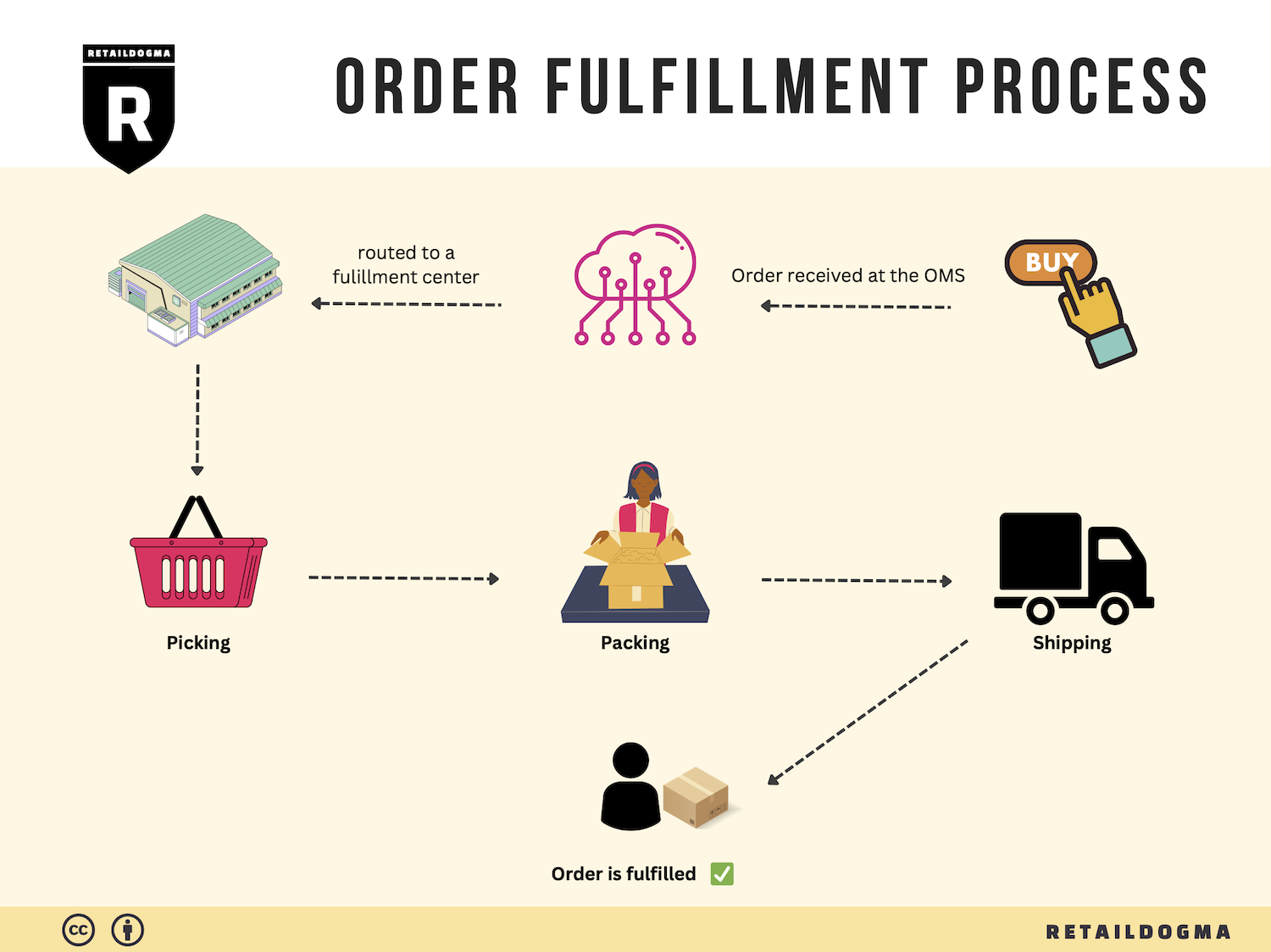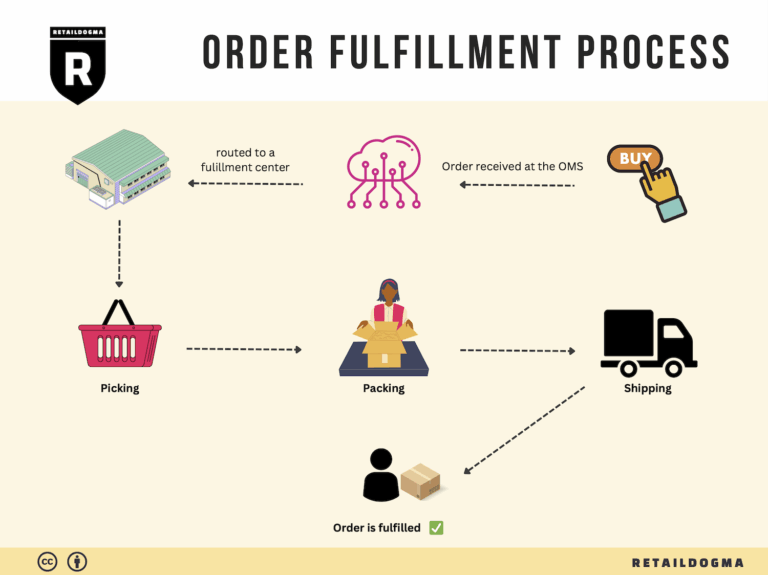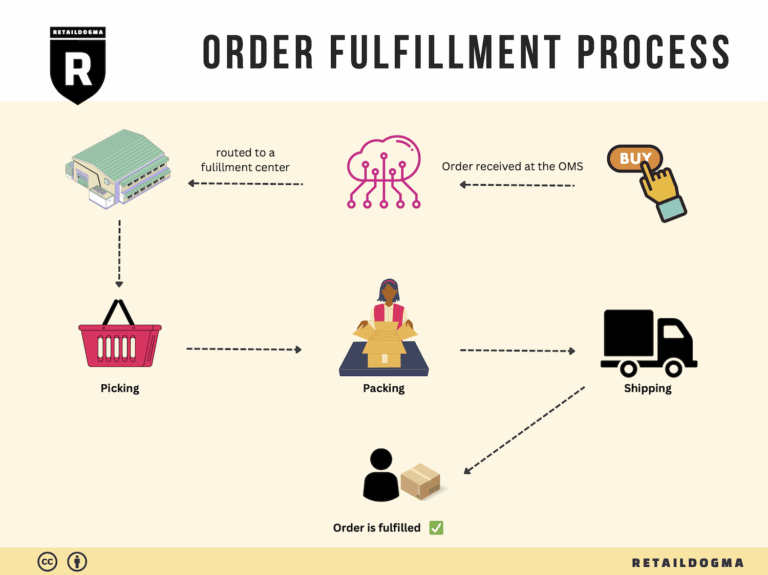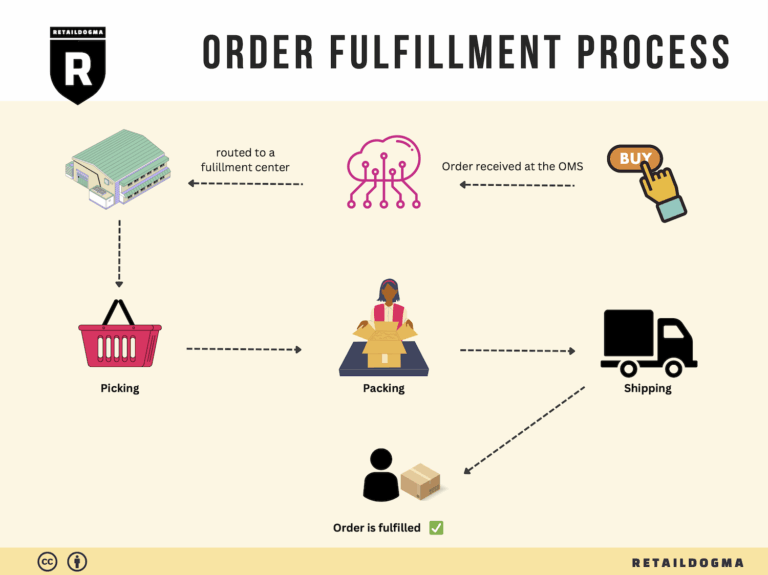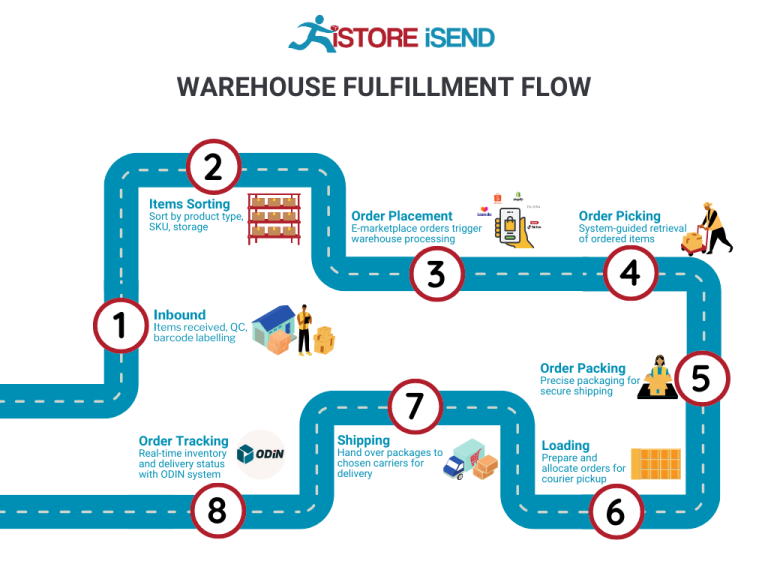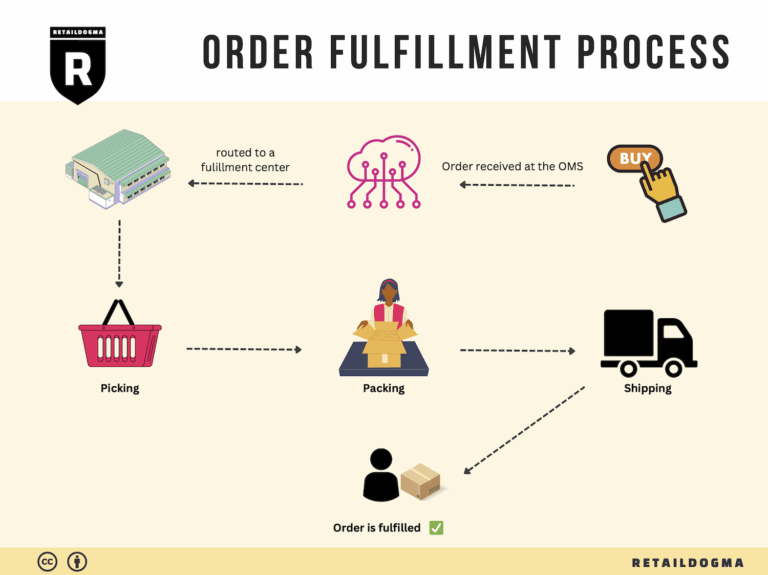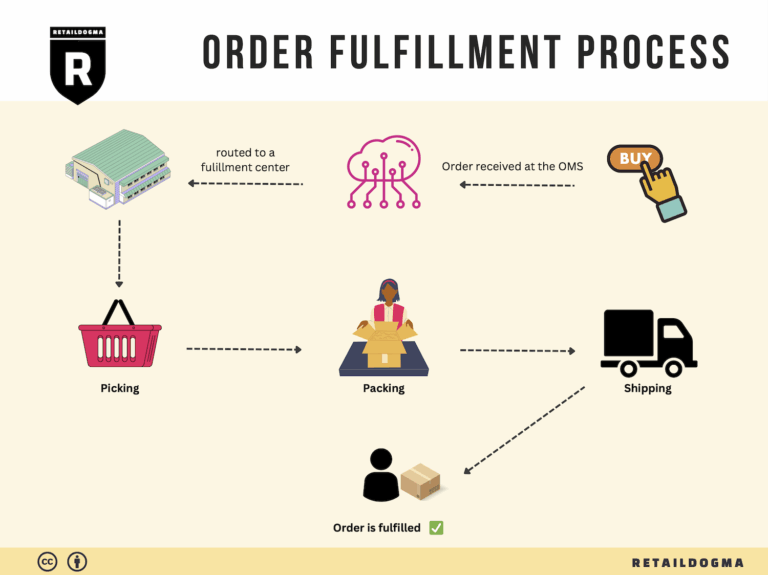What Is A Fulfillment Center? A Complete Guide (2025)
What is E-commerce Fulfillment? An Introduction for Growing Businesses
Understanding E-commerce Fulfillment: A Critical Component for Growth
As an e-commerce business owner, you may find yourself overwhelmed by the sheer volume of orders coming in. The excitement of growth can quickly turn into stress as you grapple with packing and shipping each order efficiently. This is where e-commerce fulfillment comes into play. Simply put, fulfillment is the process of getting a product from your inventory to your customer’s doorstep. It encompasses everything from warehousing and inventory management to order processing and shipping.
In this guide, we will explore the various fulfillment models available to growing businesses, including Third-Party Logistics (3PL) and Fulfillment by Amazon (FBA). Each model offers distinct advantages and can be tailored to fit your specific needs. Understanding these options will help you identify the right path for scaling your operations while maintaining excellent customer service.
We will also delve into the core services associated with fulfillment, such as order picking, packing, and shipping, as well as value-added services like kitting, labeling, and returns management. These services are essential not just for streamlining operations, but also for enhancing the overall customer experience. A well-managed fulfillment process can differentiate your brand in a competitive market.
Choosing the right fulfillment partner is a critical decision that can significantly impact your business’s efficiency and profitability. We will guide you through the key factors to consider when selecting a fulfillment provider, including location, technology integration, and service offerings. Additionally, we will discuss pricing structures, helping you understand how to evaluate costs and maximize your return on investment.
The ultimate goal of this guide is to empower you with the knowledge necessary to make informed decisions about your logistics strategy. By optimizing your fulfillment process, you can focus on what you do best: growing your business. Whether you are just starting out or looking to scale your operations, understanding fulfillment is essential for meeting customer expectations and achieving long-term success in the e-commerce landscape.
What You’ll Learn In This Guide
- What is E-commerce Fulfillment? An Introduction for Growing Businesses
- The Order Fulfillment Process: From ‘Buy’ Button to Customer’s Door
- Comparing Fulfillment Models: In-House vs. 3PL vs. Dropshipping
- A Deep Dive into Amazon FBA: Pros, Cons, and Who It’s For
- Core Services Offered by Fulfillment Centers
- How to Choose a Fulfillment Partner: A 6-Point Checklist
- Understanding Fulfillment Pricing: A Breakdown of Common Fees
- Frequently Asked Questions (FAQs) about Fulfillment
- Conclusion: Is Outsourcing Fulfillment the Right Move for Your Business?
- Important Disclaimer
The Order Fulfillment Process: From ‘Buy’ Button to Customer’s Door
1. Receiving Inventory
The first step in the order fulfillment process is receiving inventory. This is where products arrive at the fulfillment center from manufacturers or suppliers. Upon arrival, each item is inspected for quality and accuracy against the purchase order. This process typically involves the use of Stock Keeping Units (SKUs), unique identifiers assigned to each product.
Importance: Receiving inventory correctly is crucial as it sets the foundation for all subsequent operations. Mistakes at this stage can lead to stock discrepancies, which can cause delays in order fulfillment and customer dissatisfaction. Proper inventory management ensures that the right products are available when needed, minimizing the risk of stockouts or overstock situations.
2. Warehouse Storage
Once inventory is received and verified, it is moved into storage. Efficient warehouse storage involves organizing products in a way that maximizes space and accessibility. Fulfillment centers often utilize a systematic approach, such as zone storage or ABC analysis, where items are categorized based on demand frequency.
Importance: Effective storage solutions are vital for operational efficiency. They enable quick access to products when orders come in, reducing the time it takes to fulfill those orders. Additionally, well-organized storage can enhance inventory accuracy, making it easier to track stock levels and manage reordering.
3. Order Picking
The next step is order picking, where items are selected from the warehouse to fulfill customer orders. This process can be streamlined using pick lists, which are generated based on incoming orders. Pick lists provide the necessary information on which items to retrieve and their respective locations within the warehouse.
Importance: Order picking is one of the most labor-intensive and time-consuming parts of the fulfillment process. By optimizing this step—through methods such as batch picking or wave picking—businesses can significantly reduce order processing times. Accurate picking is essential to ensure that customers receive the correct items, fostering customer satisfaction and loyalty.
4. Order Packing
After items are picked, they move to the packing station. Here, products are carefully packed into boxes or containers. This stage may include quality checks to ensure that the correct items are packed and that they are in good condition. Packaging materials are chosen based on the product type and shipping requirements, and custom packaging solutions can enhance the unboxing experience for customers.
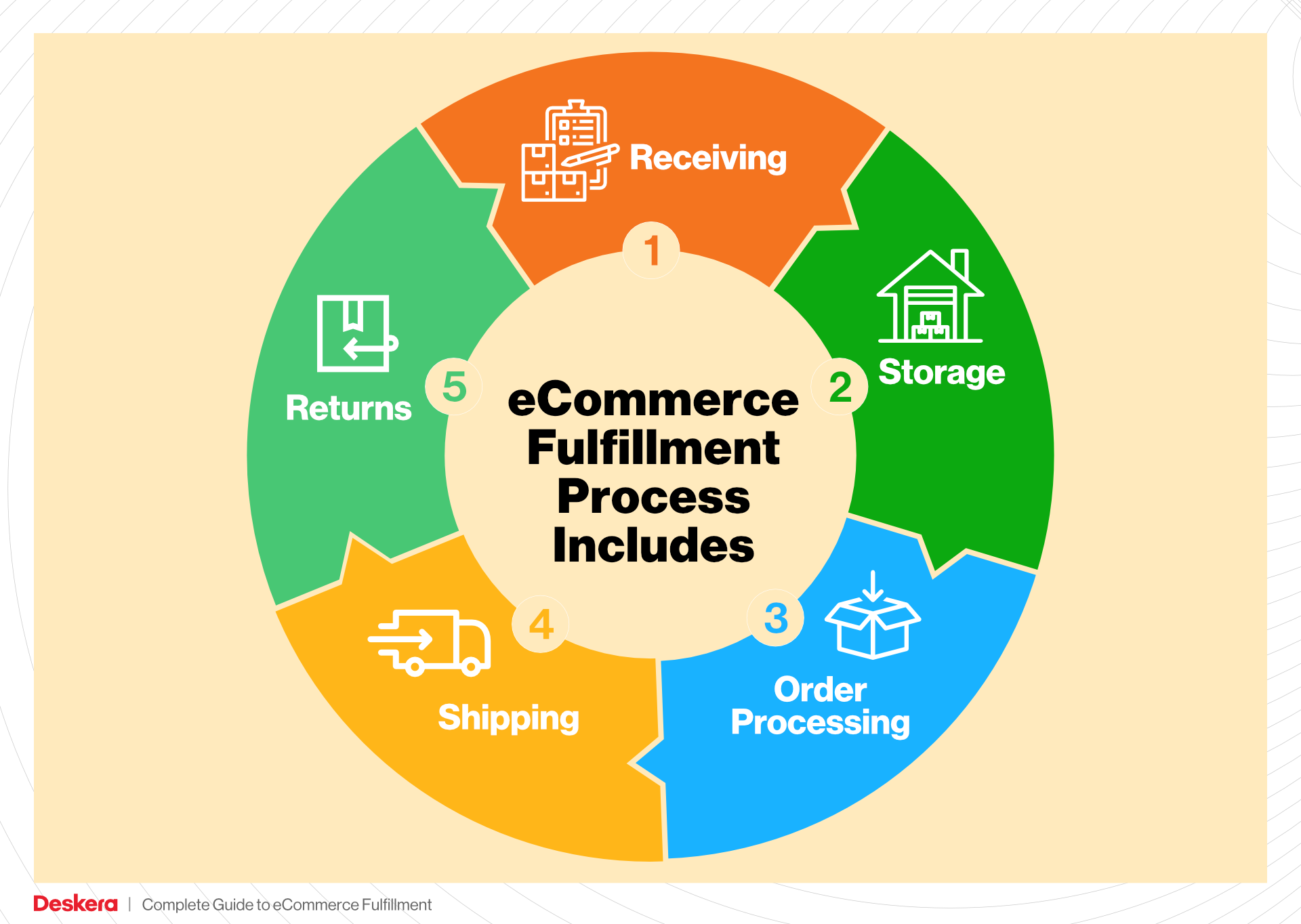
Importance: Proper packing is critical for protecting products during transit and ensuring they arrive at the customer’s door in perfect condition. Additionally, efficient packing can help reduce shipping costs by minimizing dimensional weight. Custom packaging can also provide a branding opportunity, making the delivery a part of the customer experience.
5. Shipping & Delivery
The final step in the order fulfillment process is shipping and delivery. Once packed, orders are labeled and dispatched to shipping carriers. Businesses must choose the right shipping methods based on factors such as cost, speed, and destination. Tracking systems are often employed to keep customers informed about their order status from dispatch to delivery.
Importance: Timely and accurate shipping is paramount for customer satisfaction. It directly impacts a customer’s perception of the brand and their likelihood of repeat business. By leveraging technology for tracking and communication, businesses can enhance transparency and build trust with their customers. Additionally, effective shipping strategies can help control costs and optimize delivery times, making the business more competitive in the market.
By understanding and optimizing each step of the order fulfillment process, e-commerce businesses can enhance operational efficiency, reduce costs, and significantly improve customer satisfaction. Implementing best practices in receiving, storage, picking, packing, and shipping not only streamlines logistics but also positions businesses for scalable growth in the competitive e-commerce landscape.
Comparing Fulfillment Models: In-House vs. 3PL vs. Dropshipping
Fulfillment Model Comparison
| Model | Who Handles Inventory | Best For (Business Stage) | Key Advantage | Key Disadvantage |
|---|---|---|---|---|
| In-House Fulfillment | The business itself | Startups to Established Brands | Full control over operations and branding | High overhead costs and resource-intensive |
| Third-Party Logistics (3PL) | 3PL provider | Growing to Mid-Market Brands | Cost-effective with expertise in logistics | Less control over operations and potential hidden fees |
| Dropshipping | Supplier or manufacturer | Startups and Small Businesses | Low overhead with no need for inventory storage | Lower profit margins and less control over fulfillment |
In-House Fulfillment
In-house fulfillment refers to a business managing its own warehousing, inventory, and shipping processes. This model allows for complete control over the logistics chain, from the moment products are received until they are delivered to the customer. Businesses that choose in-house fulfillment often do so to maintain brand integrity, as they can customize packaging and handle customer service directly. This model is ideal for established brands with stable sales, as it requires significant investment in storage space, labor, and technology to manage inventory effectively. However, the key disadvantage is the high overhead costs associated with maintaining a fulfillment center, which can limit scalability and flexibility. Additionally, managing logistics internally can be resource-intensive, taking focus away from core business activities like product development and marketing.
Third-Party Logistics (3PL)
Third-party logistics (3PL) providers are third-party companies that handle warehousing, fulfillment, and shipping on behalf of other businesses. This model is particularly beneficial for e-commerce brands looking to scale without the burden of managing logistics themselves. By outsourcing fulfillment to a 3PL like Baja Fulfillment, businesses can tap into specialized expertise, reduce overhead costs, and benefit from economies of scale. 3PLs often provide a suite of services, including inventory management, order processing, and returns handling, which can enhance operational efficiency. Additionally, they typically have established relationships with shipping carriers, allowing for discounted shipping rates. However, one of the main drawbacks is the loss of direct control over the fulfillment process. Businesses may encounter challenges related to transparency, responsiveness, and hidden fees, making it crucial to choose a reputable provider with a proven track record.
Dropshipping
Dropshipping is a fulfillment model where the retailer does not keep products in stock but instead transfers customer orders to a supplier, who then ships the products directly to the customer. This approach allows e-commerce businesses to operate with minimal overhead, as there is no need for inventory management or warehousing. This model is particularly appealing for startups and small businesses looking to test new products without financial risk. The primary advantage of dropshipping is the low barrier to entry, enabling entrepreneurs to launch e-commerce stores quickly and easily. However, the major downside is the lower profit margins, as suppliers typically charge a premium for handling fulfillment. Moreover, businesses have limited control over product quality, shipping times, and customer service, which can negatively impact the customer experience. As a result, while dropshipping offers flexibility, it requires careful supplier selection and effective management of customer expectations.
Conclusion
Choosing the right fulfillment model is crucial for e-commerce businesses aiming to scale operations effectively. Each model—In-House Fulfillment, Third-Party Logistics, and Dropshipping—offers distinct advantages and disadvantages that align with different business stages and goals. In-house fulfillment provides control but comes with high overhead, while 3PL offers efficiency and expertise at the cost of some operational control. Dropshipping presents a low-risk entry point but can result in thinner margins and quality concerns. Evaluating these factors based on your business needs, resources, and growth aspirations will guide you in selecting the most appropriate fulfillment strategy.
A Deep Dive into Amazon FBA: Pros, Cons, and Who It’s For
Understanding Fulfillment by Amazon (FBA)
Fulfillment by Amazon (FBA) is a service provided by Amazon that allows sellers to store their products in Amazon’s fulfillment centers. Amazon then takes care of storage, packaging, and shipping of the products directly to customers. This service enables sellers to leverage Amazon’s extensive logistics network and customer base while focusing on growing their business.
How FBA Works
-
Product Listing: Sellers create product listings on Amazon and choose which products they want to enroll in the FBA program.
-
Shipping Inventory: Sellers send their products to Amazon’s fulfillment centers. Amazon provides specific guidelines on how to prepare and package items for shipment.
-
Storage: Once the products arrive at the fulfillment center, they are stored until sold. Sellers can track their inventory through the Amazon Seller Central platform.
-
Order Fulfillment: When a customer places an order for a product listed under FBA, Amazon picks, packs, and ships the item directly to the customer. This includes providing customer service and handling returns.
-
Payment: Sellers receive payments for their sales minus the fees associated with using FBA, which include storage and fulfillment fees.

Pros of Using FBA
-
Prime Eligibility: Products fulfilled through FBA are eligible for Amazon Prime, which attracts millions of Prime members looking for fast shipping options. This can significantly increase sales, as many customers filter their searches to show only Prime-eligible products.
-
Customer Trust: Leveraging Amazon’s brand reputation instills confidence in customers. When buyers see that a product is fulfilled by Amazon, they often feel more secure about their purchase, leading to higher conversion rates.
-
Multi-Channel Fulfillment: FBA allows sellers to fulfill orders from other sales channels through Amazon’s logistics network. This means that whether you sell on your website, eBay, or Etsy, you can still utilize Amazon’s fulfillment services, simplifying your logistics operations.
-
Scalability: FBA enables sellers to scale their businesses quickly. With Amazon handling storage and shipping, sellers can focus on sourcing and marketing their products without worrying about logistics.
-
Comprehensive Customer Service: Amazon manages customer service inquiries and returns for FBA products, freeing sellers from these time-consuming tasks and allowing them to focus on other aspects of their business.
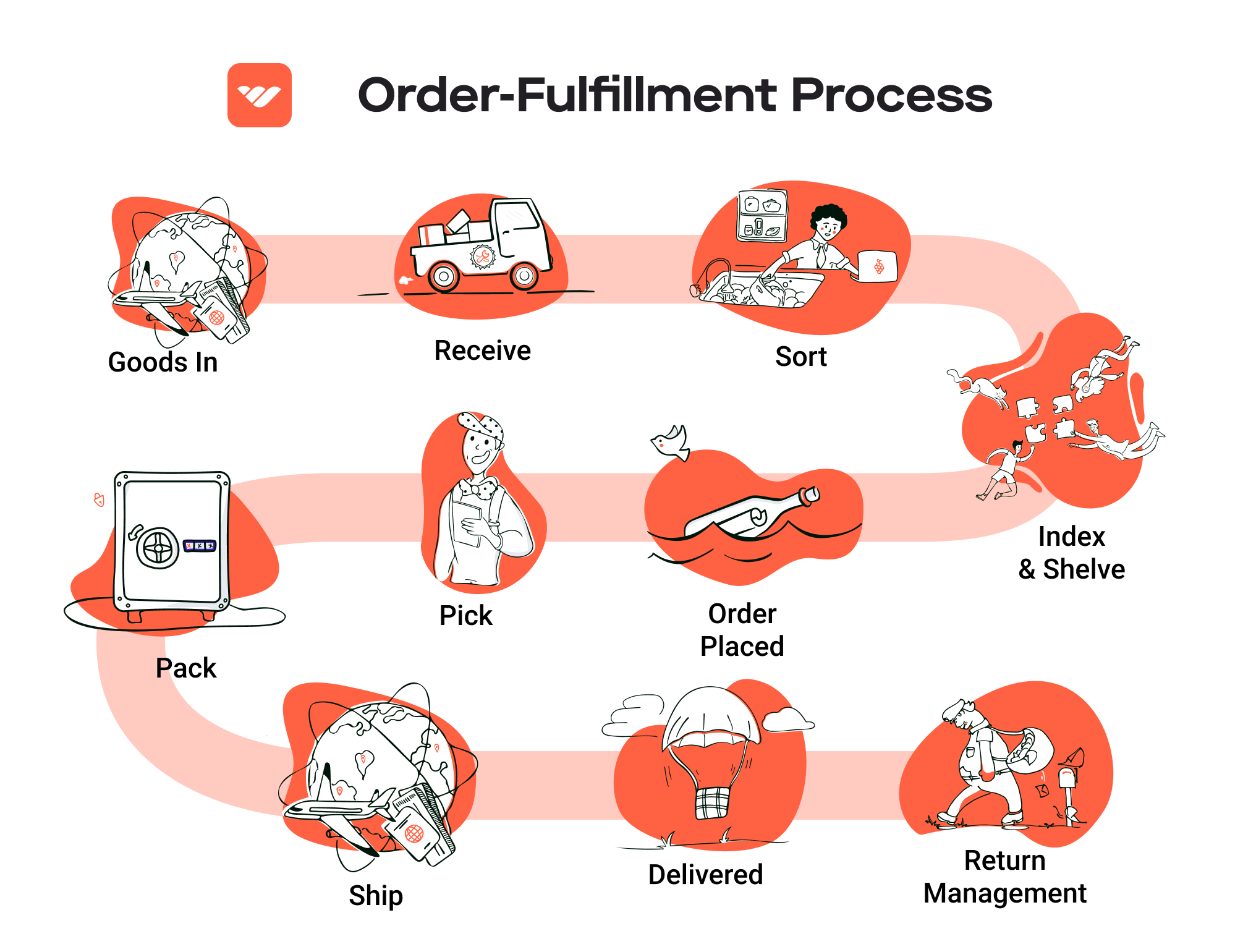
Cons of Using FBA
-
High Fees: FBA comes with various fees, including storage fees (charged monthly based on the space your inventory occupies) and fulfillment fees (charged per unit sold). These costs can add up quickly, especially for low-margin products, impacting profitability.
-
Strict Inventory Rules: Amazon has strict guidelines regarding inventory management. Sellers must ensure their products meet Amazon’s standards, or risk incurring additional fees or having their inventory removed. This can be cumbersome for sellers with a large and varied inventory.
-
Commingling Risks: FBA utilizes a commingling process where products from different sellers may be stored together. This can lead to issues if a customer receives a damaged or counterfeit item that does not belong to the seller. Sellers are responsible for the quality of their products, and this risk can undermine their brand reputation.
-
Limited Control Over Branding: While Amazon handles the logistics, sellers have limited control over the packaging and presentation of their products. This can be a disadvantage for brands that prioritize a unique unboxing experience or branded packaging.
-
Inventory Management Challenges: Managing stock levels can be tricky with FBA. Sellers need to predict demand accurately to avoid stockouts or excess inventory, which can lead to increased storage fees.
Who is FBA Best For?
Fulfillment by Amazon is particularly well-suited for:
-
Small to Medium-Sized Businesses: Those looking to scale quickly without investing heavily in logistics infrastructure can benefit from FBA’s services.
-
New Sellers: Entrepreneurs just starting out who want to leverage Amazon’s brand and customer trust can find FBA a valuable tool to establish their presence.
-
Brands with High Turnover Products: Sellers with fast-moving consumer goods or seasonal products can take advantage of FBA to ensure timely delivery and customer satisfaction.
-
Multi-Channel Sellers: Businesses that sell on various platforms and want to streamline their fulfillment process can benefit from FBA’s multi-channel capabilities.
-
Sellers Who Prioritize Convenience: Those who prefer to focus on product sourcing and marketing rather than logistics and customer service will find FBA appealing.
In conclusion, Fulfillment by Amazon offers a powerful solution for e-commerce sellers looking to streamline their logistics and tap into Amazon’s vast customer base. However, it is essential to weigh the pros and cons carefully and consider how FBA fits into your overall business strategy before making a commitment.
Core Services Offered by Fulfillment Centers
Inventory Management & Warehousing
Effective inventory management and warehousing are critical components of a successful e-commerce operation. Fulfillment centers provide businesses with sophisticated inventory tracking systems that allow for real-time visibility into stock levels, order statuses, and location of goods. By utilizing advanced technologies such as RFID and barcode scanning, these centers streamline the process of inventory control.
The benefits of robust inventory management are manifold. First, it minimizes the risk of stockouts and overstocking, which can lead to lost sales or increased holding costs. With accurate data at their fingertips, e-commerce businesses can make informed decisions about restocking and production schedules. Additionally, fulfillment centers often employ strategic warehousing solutions, placing products in locations that optimize shipping routes and reduce transit times. This geographical advantage can lead to faster delivery to customers, enhancing satisfaction and loyalty.
Pick and Pack Services
Pick and pack services are at the heart of fulfillment operations. This process involves selecting items from the warehouse (picking) and preparing them for shipment (packing). Fulfillment centers typically use automated systems and trained staff to ensure that orders are fulfilled quickly and accurately.
The primary benefit of pick and pack services is efficiency. With skilled personnel and optimized workflows, fulfillment centers can significantly reduce the time taken from order placement to dispatch. This speed is crucial for maintaining a competitive edge in the fast-paced e-commerce environment. Moreover, accurate picking and packing minimize errors, which can lead to costly returns and dissatisfied customers. By outsourcing these tasks to a fulfillment center, businesses can focus on core activities such as marketing and product development, ultimately driving growth.
Kitting and Assembly
Kitting and assembly services involve grouping individual items together into ready-to-ship sets or kits. This can include anything from bundling related products to assembling complex items that require multiple components. Fulfillment centers often offer these services as part of their value-added offerings.
The advantages of kitting and assembly are particularly relevant for e-commerce brands looking to enhance their product offerings. By providing customers with pre-packaged sets or customized kits, businesses can create unique selling propositions that differentiate them from competitors. This service also streamlines the order fulfillment process, as items are prepared in advance, reducing the time needed for order processing. Furthermore, kitting can improve inventory management by consolidating multiple SKUs into one, simplifying stock tracking and reducing the complexity of warehousing operations.
Returns Management (Reverse Logistics)
Returns management, or reverse logistics, is a crucial aspect of the e-commerce fulfillment process. This service entails handling product returns efficiently, from receiving returned items to restocking or processing refunds. Fulfillment centers typically have established protocols for managing returns, including quality checks and inventory updates.
The benefits of effective returns management are significant. A streamlined return process can enhance customer satisfaction by making it easy for consumers to return products. This is particularly important in e-commerce, where customers may hesitate to make a purchase if they perceive return policies as cumbersome. By improving the returns experience, fulfillment centers can help businesses retain customers and foster loyalty.
Additionally, efficient returns management can provide valuable insights into product performance and customer preferences. By analyzing return data, businesses can identify trends and make informed decisions regarding product offerings, marketing strategies, and inventory management. This proactive approach not only enhances operational efficiency but also contributes to overall business growth.
Conclusion
In summary, fulfillment centers offer a comprehensive suite of services that are essential for scaling e-commerce operations. From inventory management and pick and pack services to kitting and returns management, these core offerings enable businesses to streamline their logistics, enhance customer satisfaction, and ultimately drive growth. By leveraging the expertise and resources of fulfillment centers, e-commerce brands can focus on their strategic objectives while ensuring that their logistical needs are met efficiently and effectively.
How to Choose a Fulfillment Partner: A 6-Point Checklist
Location & Warehouse Network
Importance: The location of your fulfillment partner’s warehouses plays a crucial role in shipping efficiency, delivery times, and overall logistics costs. A well-placed network can minimize transit times and shipping expenses, especially for businesses targeting both domestic and international customers.
Questions to Ask:
– Where are your fulfillment centers located, and how do they relate to my primary customer base?
– Do you have facilities that can handle cross-border logistics, particularly between the U.S. and Mexico?
– Can you provide details on your warehouse capacity and the geographic coverage of your network?
Technology & Integrations
Importance: In today’s fast-paced e-commerce environment, robust technology is essential for tracking inventory, managing orders, and ensuring seamless operations. A partner that offers advanced technology and integrations with your existing e-commerce platforms will enhance efficiency and provide real-time data insights.
Questions to Ask:
– What fulfillment management systems do you use, and how do they integrate with popular e-commerce platforms like Shopify, Magento, or BigCommerce?
– Do you offer real-time inventory tracking and reporting features?
– How do you handle data security and compliance with privacy regulations?
Specializations (e.g., Cold Storage, Oversized Items)
Importance: Different businesses have unique fulfillment needs based on the nature of their products. If you sell perishable goods, oversized items, or specialized products, your fulfillment partner must have the necessary capabilities to handle these items appropriately.
Questions to Ask:
– What specific types of products do you specialize in handling?
– Do you have facilities equipped for cold storage or other specialized needs?
– Can you accommodate unique packaging or handling requirements for my products?
Scalability & Capacity
Importance: As your business grows, your fulfillment needs will evolve. A partner that can scale with your business is essential to avoid operational bottlenecks and ensure you can meet customer demand without compromising service quality.
Questions to Ask:
– What is your current order processing capacity, and how quickly can you scale operations if my order volume increases?
– Have you managed rapid scaling for other clients, and can you share examples of how you successfully handled that?
– What strategies do you have in place to manage peak seasons or unexpected demand surges?
Pricing and Contracts
Importance: Understanding the cost structure and contract terms of your fulfillment partner is vital for budgeting and financial planning. Transparent pricing will help you avoid hidden fees and ensure that you can maintain healthy profit margins.
Questions to Ask:
– Can you provide a detailed breakdown of your pricing model, including storage fees, pick and pack rates, and shipping costs?
– Are there any setup fees or long-term contracts that I should be aware of?
– How do you handle pricing adjustments in response to changing volumes or market conditions?
Customer Support & Reviews
Importance: Exceptional customer support is crucial for resolving issues quickly and maintaining a smooth operation. Additionally, reviews and testimonials from other clients can provide insight into the partner’s reliability and service quality.
Questions to Ask:
– What levels of customer support do you offer (e.g., dedicated account manager, 24/7 support)?
– Can you provide references or case studies from current or previous clients?
– How do you handle disputes or issues that may arise during the fulfillment process?
Conclusion
Selecting the right fulfillment partner is a critical decision that can significantly impact your e-commerce business’s success. By using this checklist, you can evaluate potential partners based on key factors that align with your operational needs and growth goals. Conduct thorough research, ask the right questions, and ensure that your chosen partner can effectively support your logistics strategy as you scale.
Understanding Fulfillment Pricing: A Breakdown of Common Fees
Initial Setup Fees
When partnering with a fulfillment center, businesses often encounter initial setup fees. These costs are typically charged to establish the account and integrate the necessary technology for seamless operations. Setup fees can vary widely depending on the complexity of your inventory and the fulfillment center’s capabilities. For instance, if your products require specialized handling or if you need custom software integrations, the setup fees could be higher.
Typically, these fees cover:
– Account Setup: Creating your fulfillment account and profiles.
– System Integration: Linking your eCommerce platform with the fulfillment center’s management system.
– Training: Any initial training for your staff on using the system.
It’s essential to ask for a detailed breakdown of these costs upfront, as some providers may offer promotional rates that can significantly reduce or waive these fees for new clients.
Receiving Fees
Receiving fees are incurred when the fulfillment center accepts and processes your incoming inventory. This fee covers the labor involved in unloading, inspecting, and putting away your products. The calculation for receiving fees can depend on several factors, including:
- Volume of Inventory: Larger shipments may incur lower per-unit fees due to economies of scale.
- Complexity of Products: Items that require special handling or inspection may incur higher fees.
For example, if you send a shipment of 500 units, the fulfillment center might charge a flat rate plus an additional cost per unit received. It’s advisable to clarify whether these fees apply to each shipment or if they are averaged over time.
Storage Fees (per pallet/bin)
Storage fees are charged for keeping your inventory in the fulfillment center. These costs are typically calculated on a monthly basis and can be billed per pallet or per bin, depending on how your products are organized. Key points to consider include:
- Storage Unit Size: Larger pallets or bins may be charged at a higher rate.
- Duration of Storage: Some fulfillment centers may offer tiered pricing based on the length of time products remain in storage, incentivizing faster turnover.
To manage these costs effectively, consider monitoring your inventory levels closely and optimizing your stock to avoid excessive storage fees. Some fulfillment centers also offer discounted rates for long-term storage, so inquire about such options.
Pick & Pack Fees (per item/order)
Pick and pack fees are one of the most significant costs in the fulfillment process. These fees cover the labor required to retrieve items from storage, pack them for shipment, and prepare them for delivery. The calculation of pick and pack fees can vary based on:
- Number of Items per Order: Fulfillment centers may charge a flat fee for the first item and an additional fee for each subsequent item.
- Complexity of Packing: Items that require special packaging or additional materials (like bubble wrap or branded boxes) may incur extra charges.
For instance, a fulfillment center might charge $2 for the first item and $0.50 for each additional item. Understanding these fees can help you optimize your order fulfillment process and reduce costs.
Shipping Fees
Shipping fees encompass the costs associated with transporting your products to customers. These fees can vary widely based on several factors, including:
- Shipping Method: Standard shipping, expedited shipping, and international rates will differ significantly.
- Destination: Shipping costs can vary based on the distance from the fulfillment center to the customer’s location.
- Weight and Dimensions: Heavier and larger packages typically incur higher shipping fees.
Many fulfillment centers have partnerships with major carriers, allowing them to offer discounted shipping rates. Businesses should inquire about these partnerships and the potential for bulk shipping discounts based on their order volume.
Tips for Getting an Accurate Quote
-
Provide Detailed Information: When requesting a quote, offer as much detail as possible about your inventory, expected order volume, and special requirements. This will help fulfillment centers give you a more accurate estimate.
-
Compare Multiple Quotes: Don’t settle for the first quote you receive. Compare quotes from several fulfillment centers to understand the average market rates and services included.
-
Inquire About Hidden Fees: Always ask about any additional fees that may not be included in the initial quote. This may include fees for returns, special handling, or seasonal fluctuations in pricing.
-
Negotiate Terms: Don’t hesitate to negotiate terms and fees, especially if you expect high order volumes. Many fulfillment centers are willing to adjust pricing based on projected business.
-
Review the Contract: Before signing any agreements, thoroughly review the contract for clarity on all fees, terms, and conditions. Ensure you understand how each fee is calculated and under what circumstances they might change.
By understanding these common fees and following these tips, e-commerce business owners can make informed decisions when selecting a fulfillment partner and manage their logistics costs effectively.
Frequently Asked Questions (FAQs) about Fulfillment
1. What is a fulfillment center?
A fulfillment center is a third-party logistics (3PL) provider that manages the storage, packing, and shipping of products for e-commerce businesses. Unlike a traditional warehouse, which primarily stores goods, a fulfillment center handles order processing and distribution to customers, ensuring timely delivery and efficient inventory management.
2. What is the difference between a warehouse and a fulfillment center?
The key difference lies in their functions. A warehouse is primarily used for storing goods until they are needed, while a fulfillment center is designed to process customer orders. Fulfillment centers focus on picking, packing, and shipping products directly to customers, often incorporating value-added services like kitting and returns management.
3. What is a 3PL?
A third-party logistics (3PL) provider is a company that offers outsourced logistics services, including warehousing, fulfillment, and distribution. They help businesses manage their supply chain more efficiently, allowing e-commerce brands to focus on their core operations while leveraging the expertise and resources of the 3PL.
4. How much do fulfillment services cost?
Fulfillment service costs can vary widely based on factors such as order volume, storage needs, and specific services required (like kitting or custom packaging). Typically, costs include a per-order fee, storage fees, and shipping charges. Baja Fulfillment, for instance, offers transparent pricing with custom quotes based on order volume and product specifications.
5. How can Baja Fulfillment help reduce shipping costs?
Baja Fulfillment utilizes a nearshore model with strategically located facilities in Mexico and the U.S., which helps minimize transit times and shipping costs. By leveraging duty deferral programs and lower operational costs in Mexico, businesses can achieve savings on their logistics expenses while maintaining fast delivery times to customers.
6. What value-added services does Baja Fulfillment provide?
Baja Fulfillment offers a range of value-added services beyond standard warehousing and shipping. These include kitting, labeling, custom packaging, returns management, and quality checks. Such services enhance the customer experience and enable e-commerce brands to maintain a consistent and branded fulfillment process.
7. How does Baja Fulfillment handle cross-border logistics?
Baja Fulfillment specializes in cross-border logistics, utilizing its network of facilities in Mexico and the U.S. to streamline the import/export process. This includes leveraging the IMMEX program and bonded warehouses, which help reduce import duties and enhance cash flow, making it easier for businesses to operate across borders.
8. What e-commerce platforms does Baja Fulfillment integrate with?
Baja Fulfillment seamlessly integrates with various e-commerce platforms and marketplaces, including Shopify, WooCommerce, Magento, Amazon, eBay, and Walmart. This integration facilitates efficient order processing and inventory management, allowing businesses to scale their operations effectively.
9. How can Baja Fulfillment support my business in scaling operations?
Baja Fulfillment provides comprehensive logistics solutions tailored to the needs of e-commerce businesses. With no long-term contracts, transparent pricing, and the ability to handle varying order volumes, they enable brands to scale operations quickly and efficiently while maintaining quality service.
10. What should I consider when choosing a fulfillment partner?
When selecting a fulfillment partner, consider factors such as their location, service offerings, pricing structure, technology integrations, and customer service quality. It’s essential to choose a partner that aligns with your business needs and can provide the flexibility and support required for your growth strategy.
Conclusion: Is Outsourcing Fulfillment the Right Move for Your Business?
Evaluating the Benefits of Outsourcing Fulfillment
As an e-commerce business owner or operations manager, the decision to outsource fulfillment can be a pivotal one. Leveraging a fulfillment service like Baja Fulfillment can unlock significant advantages, enabling your business to thrive in a competitive landscape. The primary benefits include substantial time savings, enhanced scalability, and access to specialized expertise.
By outsourcing fulfillment, you free up valuable time that can be redirected toward strategic initiatives, such as marketing, product development, and customer engagement. This focus on core competencies often leads to improved business performance and customer satisfaction. Moreover, fulfillment services offer the scalability necessary to adapt to fluctuating demand. As your sales grow, a capable fulfillment partner can seamlessly adjust capacity, ensuring you meet customer expectations without the burden of managing increased logistics complexity.
Furthermore, partnering with a fulfillment service provides access to industry expertise and advanced technologies. These resources not only streamline operations but also enhance accuracy in inventory management and shipping processes, which are crucial for maintaining a competitive edge.
However, it is essential to choose the right fulfillment partner to align with your business goals. The ideal partner should offer strategic advantages such as cost efficiencies, robust support for cross-border logistics, and the flexibility to accommodate your unique needs.
To determine if outsourcing fulfillment is the right move for your business, consider conducting an audit of your current shipping and logistics processes. Identify inefficiencies, costs, and pain points. This evaluation will provide clarity on whether a partnership with a fulfillment center could propel your business growth and improve customer satisfaction. Take the next step toward operational excellence and explore the potential benefits of outsourcing your fulfillment needs today.
Important Disclaimer
⚠️ Important Disclaimer
The information in this guide is for educational purposes. Fulfillment services, pricing, and platform features change frequently. Always conduct your own due diligence and consult with providers directly before making business decisions.
